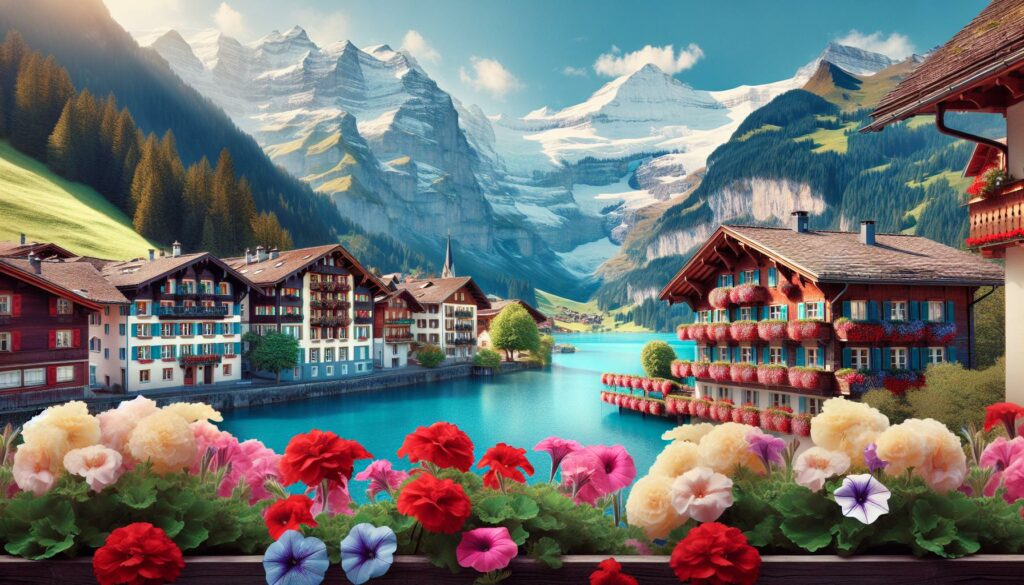Switzerland’s breathtaking landscapes have always left me in awe. From the majestic Alps piercing through cotton-like clouds to pristine lakes reflecting snow-capped peaks I’ve discovered a country that seems to have stepped right out of a fairy tale.
During my travels through this enchanting nation I’ve witnessed how nature and human ingenuity blend seamlessly. Picture-perfect villages nestle in verdant valleys while modern cities like Zurich and Geneva pulse with cosmopolitan energy against stunning natural backdrops. The Swiss have mastered the art of preserving their natural heritage while embracing progress – something I’ve found truly remarkable.
Key Takeaways
- Switzerland boasts 208 mountains over 3,000 meters, including the iconic Matterhorn, offering unparalleled natural beauty and diverse landscapes across the country
- Traditional Swiss villages feature distinctive chalet-style architecture with wooden beams, flower-filled balconies, and intricate carved details that blend seamlessly with the Alpine environment
- The country’s scenic train journeys, like the Glacier Express and Bernina Express, provide spectacular views through glass-domed carriages across dramatic mountain passes and historic viaducts
- Summer (June-September) and winter (December-March) seasons offer distinct experiences, from hiking 450+ marked trails to skiing across 7,200 km of slopes in 338 ski resorts
- Photography enthusiasts can capture stunning views from elevated viewpoints like the Sphinx Observatory (3,571m) and Gornergrat platform, especially during sunrise and golden hour
Beautiful:woqlqg7raao= Switzerland
Switzerland’s diverse topography creates an extraordinary display of natural phenomena. I’ve encountered some of Earth’s most remarkable landscapes while exploring this Alpine nation.
Alpine Mountains and Peaks
The Swiss Alps dominate the landscape with 208 mountains exceeding 3,000 meters in height. The iconic Matterhorn stands at 4,478 meters, featuring a distinctive pyramid shape that’s recognizable worldwide. During my visits, I’ve observed glacial formations across 1,800 square kilometers of Alpine terrain, including the massive Aletsch Glacier extending 23 kilometers. The peaks showcase:
- Pristine snow fields covering 40% of the Alpine region
- Exposed rock formations dating back 400 million years
- Protected Alpine meadows hosting 2,500 plant species
- Year-round glacial ice caves with natural blue ice formations
- Turquoise mountain lakes fed by glacial melt
- The Rhine Falls, dropping 23 meters across 150 meters width
- Lake Lucerne’s four arms cutting through mountain valleys
- 500 documented waterfalls in the Lauterbrunnen Valley alone
| Natural Feature | Statistical Data |
|---|---|
| Alpine Peaks > 3,000m | 208 |
| Glacier Coverage | 1,800 km² |
| Number of Lakes | 1,500 |
| Water Visibility Depth | 30 meters |
Picture-Perfect Swiss Villages
Throughout Switzerland’s valleys nestled between towering peaks, I’ve discovered villages that embody postcard-worthy charm. These settlements showcase centuries-old architectural traditions blended with meticulous Swiss precision.
Traditional Alpine Architecture
Swiss mountain villages feature distinctive chalet-style buildings with wide eaves, exposed wooden beams, and sturdy stone foundations. I observe how local builders adapt their designs to the alpine environment, using steep-pitched roofs to handle heavy snowfall. The weathered wooden facades display intricate carved details, geometric patterns, and protective shutters painted in traditional colors like forest green or deep red.
Colorful Flower-Filled Balconies
Swiss village homes transform into living gardens with cascading geraniums, petunias, and trailing lobelia spilling from wooden balcony boxes. I note how these vibrant floral displays contrast beautifully against dark timber facades from June through September. The tradition of decorating balconies with flowers dates to the 18th century when villagers competed for the most impressive botanical displays, creating a practice that continues in modern Swiss communities.
| Traditional Swiss Village Features | Typical Characteristics |
|---|---|
| Chalet Construction Materials | Timber, Stone, Slate |
| Common Balcony Flowers | Geraniums, Petunias, Lobelia |
| Decorative Elements | Carved Wood, Painted Shutters |
| Peak Blooming Season | June – September |
Scenic Train Journeys Through Switzerland
Switzerland’s rail network offers panoramic views through glass-domed carriages, connecting iconic destinations across the Alps. I’ve experienced these engineering marvels that traverse dramatic mountain passes, pristine valleys, and historic viaducts.
The Glacier Express
The Glacier Express connects Zermatt to St. Moritz in an 8-hour journey spanning 291 kilometers across 291 bridges and through 91 tunnels. The train climbs the 2,033-meter Oberalp Pass, showcasing the Rhône glacier, alpine meadows, and traditional mountain villages. Passengers view the landscape through panoramic windows while the train maintains a steady pace of 24 mph to optimize sightseeing opportunities.
The Bernina Express
The Bernina Express travels from Chur to Tirano, crossing the Alps between Switzerland and Italy on UNESCO World Heritage railways. The route features:
- Landwasser Viaduct: A 65-meter-high curved limestone bridge
- Bernina Pass: Reaching an altitude of 2,253 meters
- Brusio Spiral Viaduct: A 360-degree circular track managing steep grade changes
- Poschiavo Valley: Offering views of Italian-influenced architecture
- Alp Grüm: A panoramic restaurant stop at 2,091 meters
| Feature | Detail |
|---|---|
| Journey Length | 4 hours |
| Distance | 122 kilometers |
| Tunnels | 55 |
| Bridges | 196 |
| Max Gradient | 7% |
Best Time to Visit Switzerland
Switzerland offers distinct seasonal experiences that showcase its natural beauty throughout the year. Each season presents unique opportunities to explore this Alpine paradise.
Summer Season Activities
The summer months from June to September transform Switzerland into an outdoor adventure playground with temperatures ranging from 18°C to 28°C (65°F to 82°F).
Key summer activities include:
- Hiking 450+ marked Alpine trails in regions like Zermatt Base Camp
- Swimming in 7,000+ pristine mountain lakes including Lake Geneva
- Mountain biking across 87,000 km of marked cycling routes
- Paragliding from peaks in Interlaken with views of the Jungfrau
- Attending cultural festivals like the Montreux Jazz Festival in July
Winter Wonderland Experience
Switzerland’s winter season spans from December to March, creating perfect conditions for snow sports with temperatures between -2°C to 7°C (28°F to 45°F).
Popular winter activities include:
- Skiing across 7,200 km of slopes in 338 ski resorts
- Snowboarding in car-free Zermatt beneath the Matterhorn
- Ice skating on natural rinks like Lake St. Moritz
- Sledding down 150 km of toboggan runs in Grindelwald
- Experiencing Christmas markets in medieval towns like Lucerne
| Season | Temperature Range | Precipitation | Peak Tourist Period |
|---|---|---|---|
| Summer | 18-28°C (65-82°F) | 78-100mm | July-August |
| Winter | -2-7°C (28-45°F) | 70-80mm | December-February |
Top Photography Spots
Switzerland’s diverse landscapes provide extraordinary photo opportunities for capturing its natural beauty. Here’s a detailed look at the most photogenic locations across the country.
Mountain Viewpoints
The Swiss Alps offer unparalleled vantage points for landscape photography. The Sphinx Observatory at Jungfraujoch sits at 3,571 meters, providing 360-degree views of the Aletsch Glacier. The Pilatus Kulm observation deck features panoramic shots of Lake Lucerne from 2,128 meters. I’ve found three specific spots that guarantee stunning shots:
- Gornergrat viewing platform captures 29 peaks above 4,000 meters including the Matterhorn
- Harder Kulm presents views of Eiger Mönch Jungfrau with two lakes in the foreground
- Schilthorn’s revolving restaurant offers sunrise shots of the Bernese Alps
- Lucerne’s Chapel Bridge frames the city with mountains reflecting in Lake Lucerne
- Bern’s UNESCO-listed Old Town showcases 6km of covered arcades dating to the 15th century
- Gruyères’ cobblestone streets lead to a 13th-century castle perched on a hilltop
- Stein am Rhein’s medieval square displays intricate frescos on building facades
| Location | Elevation (m) | Best Photography Time |
|---|---|---|
| Jungfraujoch | 3,571 | Early morning |
| Pilatus Kulm | 2,128 | Golden hour |
| Gornergrat | 3,089 | Sunrise/Sunset |
| Harder Kulm | 1,322 | Late afternoon |
Switzerland has left an indelible mark on my heart with its unparalleled beauty and charm. From snow-capped peaks to flower-adorned villages the country offers a visual feast that’s truly beyond compare. I’ve found that no matter the season Switzerland delivers unforgettable experiences and photo opportunities that capture its essence.
The seamless blend of natural wonders pristine landscapes and well-preserved traditions creates a destination that’s nothing short of magical. Whether you’re seeking adventure cultural immersion or simply a peaceful escape Switzerland promises – and delivers – an extraordinary journey that’ll stay with you long after you’ve returned home.

